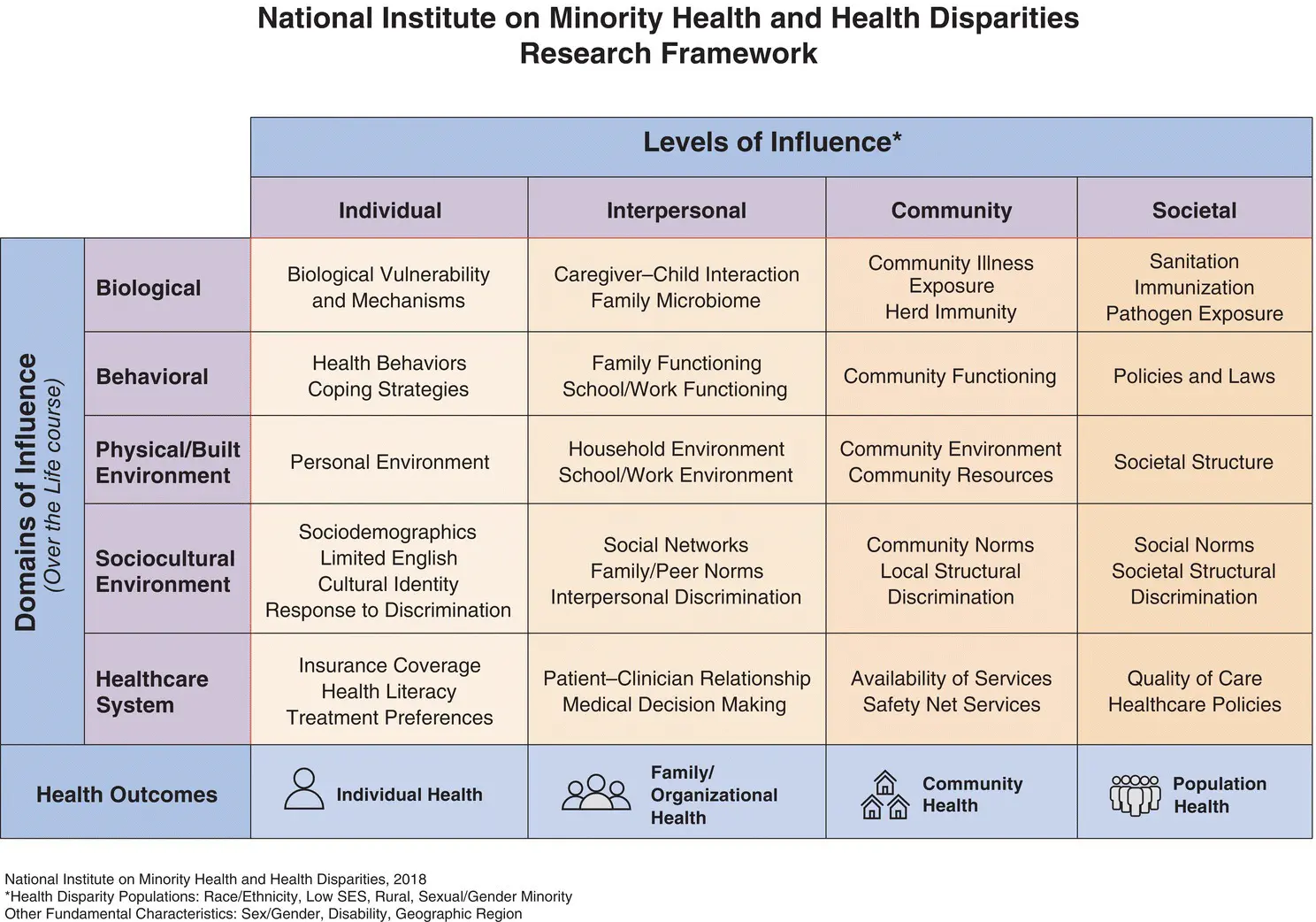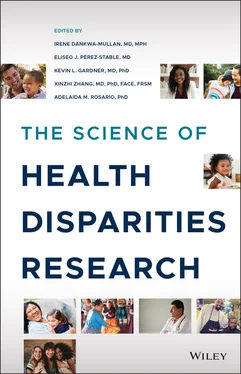1 ...7 8 9 11 12 13 ...36 The Framework reflects a hybrid of two models: the socioecological model [13] and the National Institute on Aging (NIA) Health Disparities Research Framework [14]. The socioecological model posits that health and human development are influenced by factors at multiple levels, from the individual to the macro or societal level. The NIA Framework organizes many of these factors into levels of analysis of health disparities relevant to aging research into several domains, including the biological, behavioral, sociocultural, and environmental.
The NIMHD Research Framework ( Figure 1.3) has two axes, with the Y axis depicting domains of influence on health (biological, behavioral, physical/built environment, sociocultural environment, healthcare system) and the X axis depicting levels of influence on health (individual, interpersonal, community, societal). These 20 cells portray a set of determinants, any one of which may be relevant for a particular minority health outcome or health disparity. Examples of factors within each cell are provided in Figure 1.3; this list is not intended to be comprehensive.

Figure 1.3 The NIMHD Research Framework.
Source: National Institute on Minority Health and Health Disparities. NIMHD Research Framework. 2017. Public Domain Available at: https://www.nimhd.nih.gov/about/overview/research‐framework.html. Accessed March 2, 2018.
In addition to characterizing determinants of health disparities, the Framework describes how health outcomes span multiple levels (individual, family/organizational, community, and population). Health outcomes beyond the individual level reflect collective or aggregate outcomes. Also included in the Framework are designated health disparity populations, as well as demographic factors relevant to understanding the impact of the intersectionality of population group membership—such as sex/gender, disability status, and geographic region—on minority health and health disparities. Finally, the Framework identifies the importance of a life‐course perspective when examining determinants across domains of influence, including consideration of early adverse events, chronic and cumulative social and environmental exposures, transgenerational transmission of risk and resilience, and critical periods for developing risk or resilience.
The NIMHD Research Framework is intended to convey the complexity of minority health and health disparities and the reality that focusing research exclusively on one cell of the Framework may produce incomplete knowledge. Much of the early research on minority health and health disparities used a unidimensional approach, focusing, for example, on individual behaviors and lifestyle comparisons in an effort to understand observed epidemiological differences and develop tailored interventions; or to take another example, examining the roles of language fluency and culture to understand how immigrants interacted with the healthcare system.
The role of racism and discrimination has for decades been postulated as a major contributor to adverse health outcomes, and the volume of research on this topic has steadily increased [15]. However, racism and discrimination have not been routinely included in health studies that primarily emphasize other types of determinants or etiological factors. For any particular minority health or health disparity issue, multiple factors may be relevant, from lifestyle choices, cultural beliefs, and racism and discrimination to place‐based factors such as community violence exposure, availability of green space, public transportation, and access to healthy foods. Social factors, such as social support and size and cohesiveness of social networks and macro‐level factors, such as health and other policies, are all relevant as well. The Research Framework is intended to stimulate consideration and research about potential factors and determinants of health outcomes that transcend traditional disciplinary silos or service sector boundaries.
Another principle conveyed by the NIMHD Research Framework is the importance of the interaction between biological, sociocultural, and environmental processes. Early work in minority health and health disparities often focused primarily on biological or social‐behavioral factors. The explosion of information describing and understanding biological processes and genetics has provided several plausible models for observed differences in specific conditions. The genetic contribution to the higher prevalence, earlier onset, and higher morbidity of prostate cancer among African Americans is not fully understood and warrants exploration of the social and environmental factors that may play a role in these outcomes [16].
The fact that all racial/ethnic minority groups studied in the United States have a higher prevalence of diabetes would suggest a common pathway that triggers metabolic abnormalities based on chronic stress, nutritional habits, and/or environmental interactions with genetic susceptibility. Major differences in the numbers of suicides by race/ethnicity may be explained by the interactions of underlying neurological and psychological factors with cultural and social factors that have not been measured. Minority health and health disparities researchers, who typically are aware of the social determinants of health, need also to understand and follow developments in the research on biological mechanisms, such as genetic stability, cellular function, and physiological indicators. Such integrative research requires interdisciplinary collaborations and team science approaches.
Additionally, the Framework highlights the importance of healthcare as a significant determinant of minority health and health disparity outcomes. Access to healthcare, usually defined as having health insurance coverage, an identifiable place to obtain care, and a clinician who can manage and coordinate healthcare [17] is an essential component of improving health for health disparity populations. As an increasing proportion of the population develops chronic diseases, the role that the healthcare system and clinicians have in incorporating environmental and sociocultural factors to influence health outcomes intensifies. Differences in intensity of blood pressure control, ordering and following‐up cancer screening tests, recommending and administering vaccines, and coordinating with consultants all affect health disparities. Communication and shared medical decision making between patients and clinicians are also factors relevant to health disparities. More research is needed on how race/ethnicity, SES, sexual orientation and gender identity, health literacy, limited English proficiency, and other social determinants influence patient–clinician communication and how this process may affect minority health and health disparities. At the macro‐level, local, state, and federal policies regarding availability, eligibility, and cost of healthcare can also result in disparities in access to, utilization of, and quality of care.
1.5 Inclusion of Diverse Participants in Clinical Research
The inclusion of diverse participants in clinical studies is related to minority health research but is a distinct topic. The inclusion of women, children, and minorities in clinical research was mandated by Congress in 1993. 5 Although significant progress has been made in engaging women as participants in clinical research, participation from racial/ethnic minority groups remains low. Every clinical study cannot be powered to stratify outcomes by race/ethnicity, but when the data indicate a significant disparity in rates or outcomes, there is a scientific responsibility to address diversity.
Читать дальше













